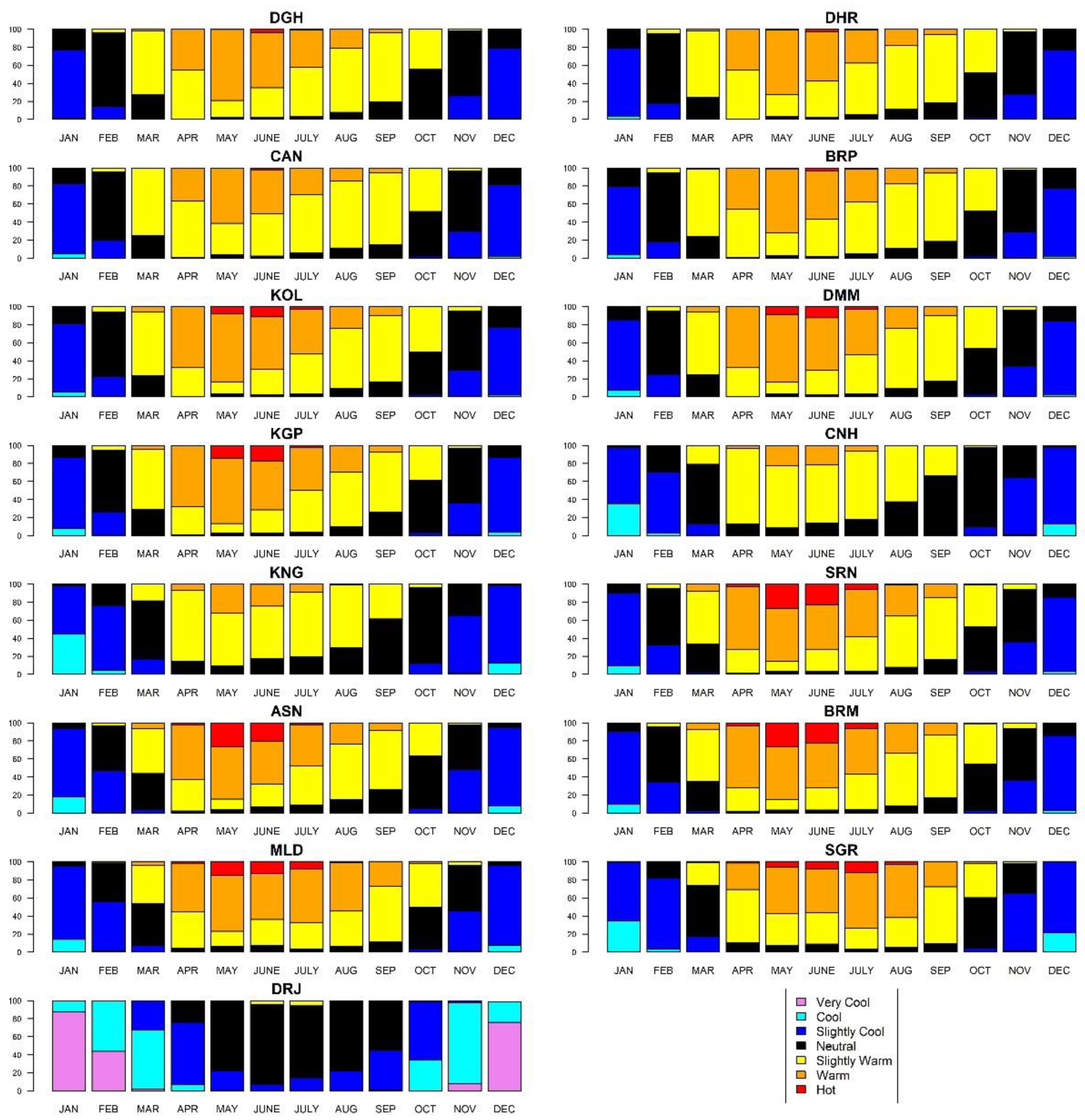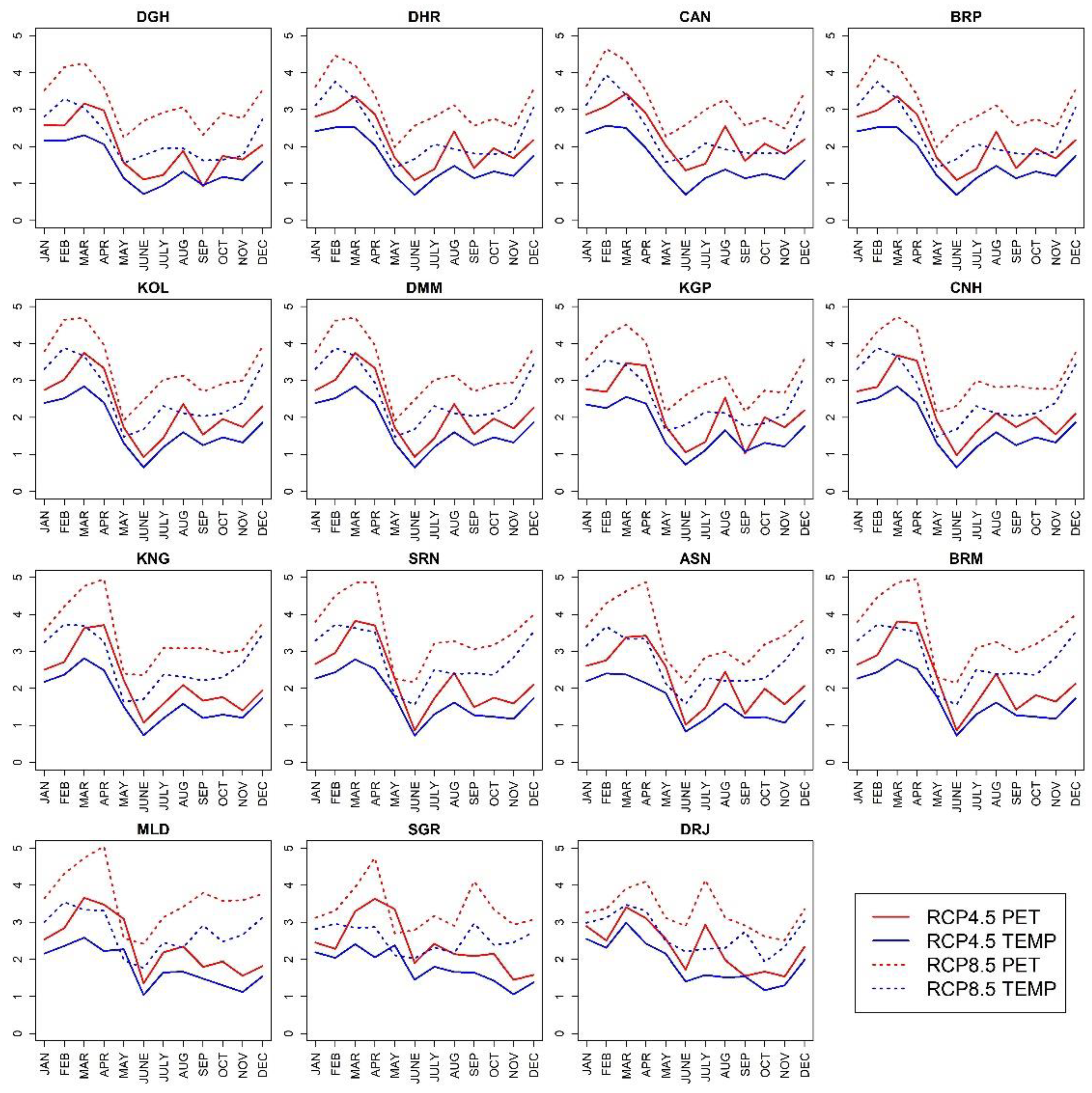Projection of Thermal Bioclimate Conditions over West Bengal, India in Response to Global Warming Based on Climate Model †
Abstract
:1. Introduction
2. Study Regions
3. Data
4. Applied Methodology
5. Results
5.1. Intra-Annual Variation of PET
5.2. Monthly Temperature and PET Differences under Different RCP Scenarios
6. Discussion
Author Contributions
Funding
Institutional Review Board Statement
Informed Consent Statement
Data Availability Statement
Acknowledgments
Conflicts of Interest
References
- Solomon, S.; Qin, D.; Manning, M.; Chen, Z.; Marquis, M.; Averyt, K.B.; Tignor, M.; Miller, H.L. (Eds.) Climate Change 2007: The Physical Science Basis; Contribution of Working Group I to the Fourth Assessment Report of the Intergovernmental Panel on Climate Change; Cambridge University Press: Cambridge, UK, 2007; pp. 1–996. [Google Scholar]
- Flato, G.; Abiodun, P.; Braconnot, S.C.; Chou, W.; Collins, P.; Cox, F.; Driouech, S.; Emori, V.; Eyring, C.; Forest, P.; et al. Evaluation of Climate Models. In Climate Change 2013: The Physical Science Basis. Contribution of Working Group I to the Fifth Assessment Report of the Intergovernmental Panel on Climate Change; Cambridge University Press: Cambridge, UK, 2014; pp. 741–866. [Google Scholar]
- Van Oldenborgh, G.; Collins, M.; Arblaster, J.; Christensen, J.H.; Marotzke, J.; Power, S.B.; Rummukainen, M.; Tianjun, Z. Annex I: Atlas of Global and Regional Climate Projections; Cambridge University Press: Cambridge, UK, 2013; pp. 1311–1393. [Google Scholar]
- Dube, R.K.; Rao, G.S.P. Extreme weather events over India in the last 100 years. J. Ind. Geophys. Union 2005, 9, 173–187. [Google Scholar]
- Jaswal, A.; Padmakumari, B.; Kumar, N.; Kore, P. Increasing trend in temperature and moisture induced heat index and its effect on human health in climate change scenario over the Indian sub-continent. J. Clim. Chang. 2017, 3, 11–25. [Google Scholar] [CrossRef]
- Pai, D.; Nair, S.; Ramanathan, A. Long term climatology and trends of heat waves over India during the recent 50 years (1961–2010). Mausam 2013, 64, 585–604. [Google Scholar] [CrossRef]
- Rohini, P.; Rajeevan, M.; Srivastava, A.K. On the variability and increasing trends of heat waves over India. Sci. Rep. 2016, 6, 26153. [Google Scholar] [CrossRef]
- Das, B.; Chakraborty, R. Climate Change Scenario of West Bengal, India: A Geo-Environmental Assessment. Indian Cartogr. 2016, 36, 425–441. [Google Scholar]
- Singh, J.; Kumar, M. Solar radiation over four cities of India: Trend analysis using Mann-Kendall statistical test. Int. J. Renew. Energy Res. 2016, 6, 1385–1395. [Google Scholar]
- Höppe, P. The physiological equivalent temperature–a universal index for the biometeorological assessment of the thermal environment. Int. J. Biometeorol. 1999, 43, 71–75. [Google Scholar] [CrossRef]
- Matzarakis, A.; Mayer, H.; Iziomon, M. Applications of a universal thermal index: Physiological equivalent temperature. Int. J. Biometeorol. 1999, 43, 76–84. [Google Scholar] [CrossRef]
- Mayer, H.; Höppe, P. Thermal comfort of man in different urban environments. Theor. Appl. Climatol. 1987, 38, 43–49. [Google Scholar] [CrossRef]
- Jendritzky, G.; Bucher, K.; Laschewski, G.; Walther, H. Atmospheric heat exchange of the human being, bioclimate assessments, mortality and thermal stress. Int. J. Circumpolar Health 2000, 59, 222. [Google Scholar]
- Staiger, H.; Laschewski, G.; Grätz, A. The perceived temperature–a versatile index for the assessment of the human thermal environment. Part A: Scientific basics. Int. J. Biometeorol. 2012, 56, 165–176. [Google Scholar] [CrossRef] [PubMed]
- Gagge, A.P.; Fobelets, A.; Berglund, L. A standard predictive Index of human reponse to thermal enviroment. Trans. Am. Soc. Heat. Refrig. Air-Cond. Eng. 1986, 92, 709–731. [Google Scholar]
- Fiala, D.; Havenith, G.; Bröde, P.; Kampmann, B.; Jendritzky, G. UTCI-Fiala multi-node model of human heat transfer and temperature regulation. Int. J. Biometeorol. 2012, 56, 429–441. [Google Scholar] [CrossRef] [PubMed]
- Jendritzky, G.; de Dear, R.; Havenith, G. UTCI—Why another thermal index? Int. J. Biometeorol. 2012, 56, 421–428. [Google Scholar] [CrossRef] [PubMed]
- Matzarakis, A. Weather-and climate-related information for tourism. Tour. Hosp. Plan. Dev. 2006, 3, 99–115. [Google Scholar] [CrossRef]
- Rodríguez-Algeciras, J.; Algeciras, J.A.R.; Chaos-Yeras, M.; Matzarakis, A. Tourism-related climate information for adjusted and responsible planning in the tourism industry in Barcelona, Spain. Theor. Appl. Climatol. 2020, 142, 1003–1014. [Google Scholar] [CrossRef]
- Chen, Y.-C.; Chen, W.-N.; Chou, C.; Matzarakis, A. Concepts and new implements for modified physiologically equivalent temperature. Atmosphere 2020, 11, 694. [Google Scholar] [CrossRef]
- Lin, T.-P.; Matzarakis, A. Tourism climate information based on human thermal perception in Taiwan and Eastern China. Tour. Manag. 2011, 32, 492–500. [Google Scholar] [CrossRef]
- Banerjee, S.; Middel, A.; Chattopadhyay, S. Outdoor thermal comfort in various microentrepreneurial settings in hot humid tropical Kolkata: Human biometeorological assessment of objective and subjective parameters. Sci. Total Environ. 2020, 721, 137741. [Google Scholar] [CrossRef]
- Das, M.; Das, A.; Mandal, S. Outdoor thermal comfort in different settings of a tropical planning region of Eastern India by adopting LCZs approach: A case study on Sriniketan-Santiniketan Planning Area (SSPA). Sustain. Cities Soc. 2020, 63, 102433. [Google Scholar] [CrossRef]
- De, B.; Mukherjee, M. Optimisation of canyon orientation and aspect ratio in warm-humid climate: Case of Rajarhat Newtown, India. Urban Clim. 2018, 24, 887–920. [Google Scholar] [CrossRef]
- Sen, J.; Nag, P.K. Human susceptibility to outdoor hot environment. Sci. Total Environ. 2019, 649, 866–875. [Google Scholar] [CrossRef] [PubMed]
- Ziaul, S.; Pal, S. Assessing outdoor thermal comfort of English Bazar Municipality and its surrounding, West Bengal, India. Adv. Space Res. 2019, 64, 567–580. [Google Scholar] [CrossRef]
- INDIA, P. Census of India 2011 Provisional Population Totals; Office of the Registrar General and Census Commissioner: New Delhi, India, 2011.
- Sanjay, J.; Krishnan, R.; Shrestha, A.B.; Rajbhandari, R.; Ren, G.-Y. Downscaled climate change projections for the Hindu Kush Himalayan region using CORDEX South Asia regional climate models. Adv. Clim. Chang. Res. 2017, 8, 185–198. [Google Scholar] [CrossRef]
- Matzarakis, A.; Rutz, F.; Mayer, H. Modelling radiation fluxes in simple and complex environments—Application of the RayMan model. Int. J. Biometeorol. 2007, 51, 323–334. [Google Scholar] [CrossRef]
- Matzarakis, A.; Rutz, F.; Mayer, H. Modelling radiation fluxes in simple and complex environments: Basics of the RayMan model. Int. J. Biometeorol. 2010, 54, 131–139. [Google Scholar] [CrossRef]
- Rao, K.K.; Kumar, T.V.L.; Kulkarni, A.; Ho, C.-H.; Mahendranath, B.; Desamsetti, S.; Patwardhan, S.; Dandi, A.R.; Barbosa, H.; Sabade, S. Projections of heat stress and associated work performance over india in response to global warming. Sci. Rep. 2020, 10, 16675. [Google Scholar]


| Sl. No. | Station | Abbreviated Station Code | Longitude | Latitude |
|---|---|---|---|---|
| 1. | Digha | DGH | 87.50° E | 21.62° N |
| 2. | Diamond Harbour | DHR | 88.20° E | 22.17° N |
| 3. | Canning | CAN | 88.67° E | 22.25° N |
| 4. | Baruipur | BRP | 88.44° E | 22.38° N |
| 5. | Alipore (Kolkata) | KOL | 88.32° E | 22.52° N |
| 6. | Dum Dum | DMM | 88.45° E | 22.63° N |
| 7. | Kharagpur | KGP | 87.32° E | 22.32° N |
| 8. | Chinsurah | CNH | 88.44° E | 22.90° N |
| 9. | Krishnanagar | KNG | 88.49° E | 23.41° N |
| 10. | Sriniketan | SRN | 87.70° E | 23.63° N |
| 11. | Asansol | ASN | 86.95° E | 23.67° N |
| 12. | Birbhum | BRM | 87.59° E | 23.81° N |
| 13. | Malda | MLD | 88.12° E | 25.02° N |
| 14. | Siliguri | SGR | 88.43° E | 26.48° N |
| 15. | Darjeeling | DRJ | 88.27° E | 27.05° N |
| Thermal Sensation | PET Range for Kolkata (°C) |
|---|---|
| Very cool/Cold | ˂3.31 |
| Cool | 3.31–11.42 |
| Slightly cool | 11.42–19.48 |
| Neutral | 19.48–27.59 |
| Slightly warm | 27.59–35.73 |
| Warm | 35.73–43.83 |
| Hot | >43.83 |
Publisher’s Note: MDPI stays neutral with regard to jurisdictional claims in published maps and institutional affiliations. |
© 2022 by the authors. Licensee MDPI, Basel, Switzerland. This article is an open access article distributed under the terms and conditions of the Creative Commons Attribution (CC BY) license (https://creativecommons.org/licenses/by/4.0/).
Share and Cite
Bal, S.; Kirchner, I. Projection of Thermal Bioclimate Conditions over West Bengal, India in Response to Global Warming Based on Climate Model. Environ. Sci. Proc. 2022, 19, 28. https://doi.org/10.3390/ecas2022-12820
Bal S, Kirchner I. Projection of Thermal Bioclimate Conditions over West Bengal, India in Response to Global Warming Based on Climate Model. Environmental Sciences Proceedings. 2022; 19(1):28. https://doi.org/10.3390/ecas2022-12820
Chicago/Turabian StyleBal, Sourabh, and Ingo Kirchner. 2022. "Projection of Thermal Bioclimate Conditions over West Bengal, India in Response to Global Warming Based on Climate Model" Environmental Sciences Proceedings 19, no. 1: 28. https://doi.org/10.3390/ecas2022-12820
APA StyleBal, S., & Kirchner, I. (2022). Projection of Thermal Bioclimate Conditions over West Bengal, India in Response to Global Warming Based on Climate Model. Environmental Sciences Proceedings, 19(1), 28. https://doi.org/10.3390/ecas2022-12820






